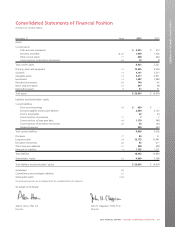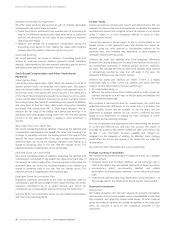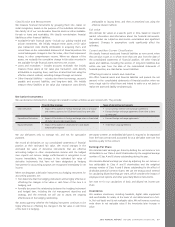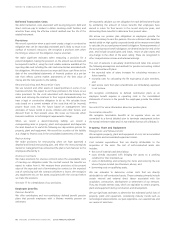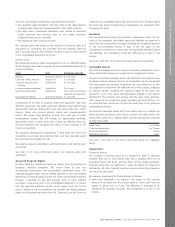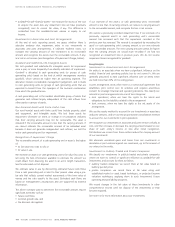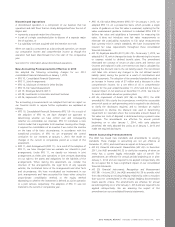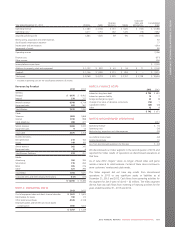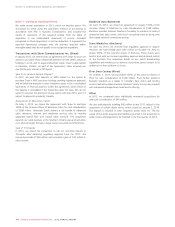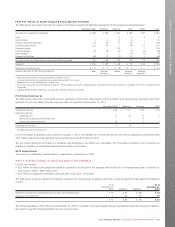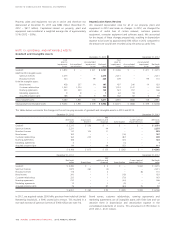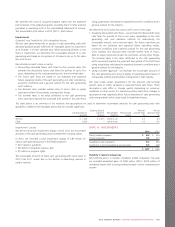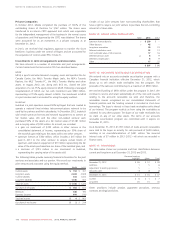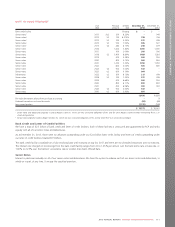Rogers 2013 Annual Report Download - page 105
Download and view the complete annual report
Please find page 105 of the 2013 Rogers annual report below. You can navigate through the pages in the report by either clicking on the pages listed below, or by using the keyword search tool below to find specific information within the annual report.
NOTES TO CONSOLIDATED FINANCIAL STATEMENTS
Discontinued Operations
A discontinued operation is a component of our business that has
operations and cash flows that are clearly distinguished from the rest of
Rogers and:
• represents a separate major line of business
• is part of a single coordinated plan to dispose of a separate major
line of business, or
• is a subsidiary we have acquired with the intention to re-sell.
When we classify a component as a discontinued operation, we restate
our comparative income and comprehensive income as though the
operation had been discontinued from the start of the comparative
year.
See note 6 for information about discontinued operations.
New Accounting Pronouncements Effective in 2013
We adopted the following accounting changes for our 2013
consolidated financial statements on January 1, 2013.
• IFRS 10, Consolidated Financial Statements
• IFRS 11, Joint Arrangements
• IFRS 12, Disclosure of Interest in Other Entities
• IFRS 13, Fair Value Measurement
• IAS 19, Employee Benefits (2011)
• IAS 28, Investments in Associates and Joint Ventures
• IAS 36, Impairment of Assets
The accounting pronouncements we adopted that had an impact on
our financial results or require further explanation are explained as
follows:
•IFRS 10, Consolidated Financial Statements (IFRS 10) – As a result of
the adoption of IFRS 10, we have changed our approach to
determining whether we have control over and consequently
whether we consolidate our investees. IFRS 10 introduces a new
control model that is applicable to all investees. Among other things,
it requires the consolidation of an investee if we control the investee
on the basis of de facto circumstances. In accordance with the
transitional provisions of IFRS 10, we re-assessed the control
conclusion for our investees at January 1, 2013. We made no
changes in the current or comparative period as a result of this
assessment.
•IFRS 11, Joint Arrangements (IFRS 11) – As a result of the adoption of
IFRS 11, we have changed how we evaluate our interests in joint
arrangements. Under IFRS 11, we classify our interests in joint
arrangements as either joint operations or joint ventures depending
on our right to the assets and obligations for the liabilities of the
arrangements. When making this assessment, we consider the
structure of the arrangements, the legal form of any separate
vehicles, the contractual terms of the arrangements and other facts
and circumstances. We have re-evaluated our involvement in our
joint arrangements and have accounted for these either using the
proportionate consolidation method, or the equity method
depending on whether the investment is defined as a joint operation
or a joint venture, respectively. The adoption of IFRS 11 was not
material to the current or comparative year.
•IFRS 13, Fair Value Measurement (IFRS 13) – On January 1, 2013, we
adopted IFRS 13, on a prospective basis, which provides a single
source of guidance on how fair value is measured, replacing the fair
value measurement guidance contained in individual IFRSs. IFRS 13
defines fair value and establishes a framework for measuring fair
value. It does not introduce new fair value measurements or
eliminate the practicability exceptions to fair value measurements
that currently exist in certain standards. We have incorporated the
relevant fair value requirements throughout these consolidated
financial statements.
•IAS 19, Employee Benefits (2011) (IAS 19) – On January 1, 2013, we
adopted IAS 19, which changes the basis for determining the income
or expense related to defined benefit plans. This amendment
eliminated the concept of return on plan assets and interest cost
(income) and replaced it with a net interest cost that is calculated by
applying the discount rate to the net liability (asset). The net interest
cost takes into account any changes in the net defined benefit
liability (asset) during the period as a result of contributions and
benefit payments. The adoption of the amended standard resulted in
an increase in finance costs of $7 million and a decrease in other
comprehensive income, for a net effect of nil in comprehensive
income for the year ended December 31, 2012 and did not have a
material impact on net assets as at December 31, 2012. See note 22
for more information about our pension plans.
•IAS 36, Impairment of Assets (IAS 36) – In May 2013, the IASB
amended IAS 36 to clarify the circumstances in which the recoverable
amount of assets or cash-generating units is required to be disclosed,
to clarify the disclosures required, and to introduce an explicit
requirement to disclose the discount rate used in determining
impairment (or reversals) where the recoverable amount (based on
fair value less costs of disposal) is determined using a present value
technique. The amendments are effective for annual periods
beginning on or after January 1, 2014, with early adoption
permitted. We early adopted this policy as of January 1, 2013 and
made the required disclosures.
Recent Accounting Pronouncements
The IASB has issued new standards and amendments to existing
standards. These changes in accounting are not yet effective at
December 31, 2013, and could have an impact on future periods.
•IAS 32, Financial Instruments: Presentation (IAS 32) – In December
2011, the IASB amended IAS 32 to clarify the meaning of when an
entity has a current legally enforceable right of set-off. The
amendments are effective for annual periods beginning on or after
January 1, 2014 and are required to be applied retrospectively. We
do not expect this to have a significant impact on our consolidated
financial statements.
•IAS 39, Financial Instruments: Recognition and Measurement
(IAS 39) – In June 2013, the IASB amended IAS 39 to provide relief
from discontinuing an existing hedging relationship when a novation
that was not contemplated in the original hedging documentation
meets specific criteria. The amendments are effective for annual
periods beginning on or after January 1, 2014 and are required to be
applied retrospectively. We are assessing the impact of this
amendment on our consolidated financial statements.
2013 ANNUAL REPORT ROGERS COMMUNICATIONS INC. 101


